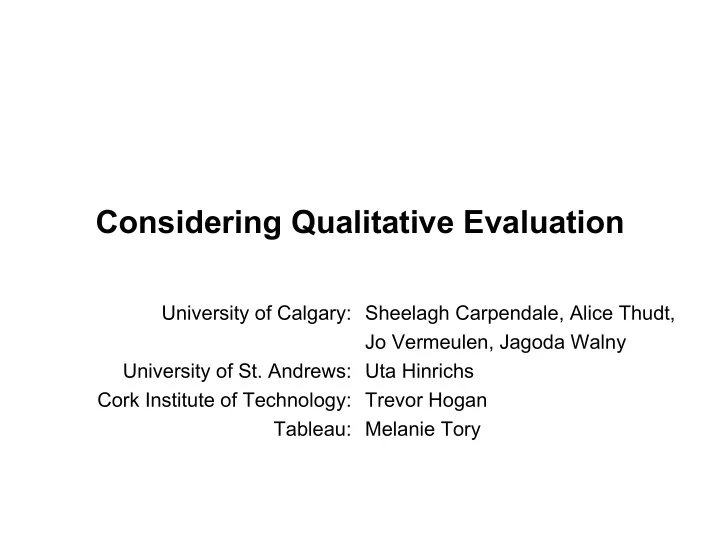

Considering Qualitative Evaluation University of Calgary: Sheelagh Carpendale, Alice Thudt, Jo Vermeulen, Jagoda Walny University of St. Andrews: Uta Hinrichs Cork Institute of Technology: Trevor Hogan Tableau: Melanie Tory
Overview Talk 1: Setting the stage: qualitative Talk 2: Observation as a skill Activity 1: Practicing observation Activity 2: Interviewing 1 Activity 3: Interviewing 2 Talk 3: Interviewing as a skill Activity 4: Interviewing 3 Panel: open discussion Talk 4: In summary – next step analysis
Taking a pencil for a walk from Paul Klee
Paul Klee’s Taking a pencil for a walk Teaches 3 things 1. About range in line drawing variations 2. About observing 3. About critique A repeatable exercise - You always learn no matter how many times you have done it
Paul Klee’s Taking a pencil for a walk Set up - you need 1. A pencil (we have some - pens will do) 2. A piece of blank paper (we have some) 3. A surface to draw on – on a book, on your laptop, …
Paul Klee’s Taking a pencil for a walk Getting started 1. Touch you pencil to your paper 2. Though you will move your pencil, you will keep it in contact with your paper for the whole exercise 3. Listen to the story and move your pencil in response to what you hear
Paul Klee’s Taking a pencil for a walk The story has stopped 1. Turn to your immediate neighbor 2. Look at your pencil walks 3. Take turns describing to each other what you see 4. Consider all things (wobblyness, vigor, tension, emotion, line quality, humor, sketchiness, …
Paul Klee’s Taking a pencil for a walk Teaches 3 things 1. About range in line drawing variations 2. About observing 3. About critique A repeatable exercise - You always learn no matter how many times you have done it
Paul Klee’s Taking a pencil for a walk • Questions? • Discussion? • Comments?
Observation Techniques Very little written about what to observe All factors - What is said - All physical factors - Posture - Expressions - Hand actions - Etc. - Any ambience - Any emotions - Levels of observation – leads back to self as lens
Observation Techniques observational records • unobtrusive • as observations occur • avoid note taking impact • minimize the time gap (memory drops off rapidly) • Include setting – description of the physical setup, – the time, – who is present, etc. • Drawing maps of layouts and activities useful Barzun, J., Graff, H.: The Modern Researcher, 3rd edn. Harcourt Brace Jovanvich, New York (1977)
Observation Techniques • include the overt and covert in activities and communications. – body language – gestures, especially if it gets understood and acted upon, is just – careful of grey area where extent of communication unclear • include the positive and negative. – Frustrations – difficulties • good note taking habits – can lose important notes on back of another • be concrete • distinguish between – verbatim accounts – paraphrased and/or remembered. Barzun, J., Graff, H.: The Modern Researcher, 3rd edn. Harcourt Brace Jovanvich, New York (1977)
Recommend
More recommend